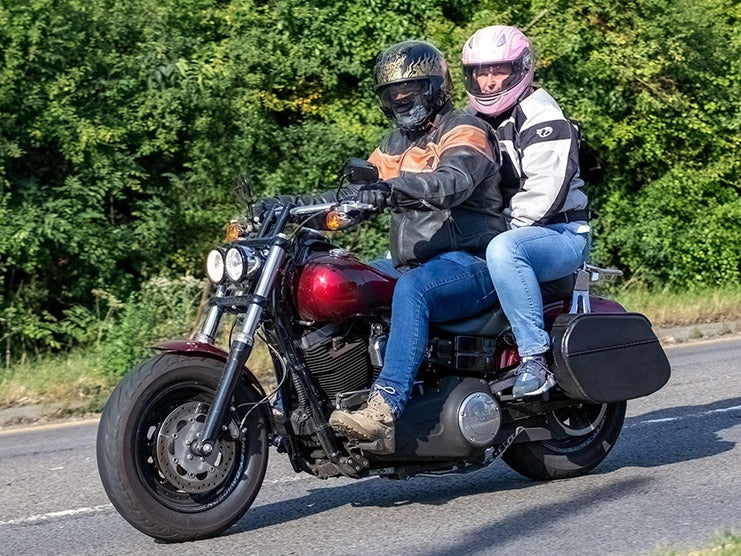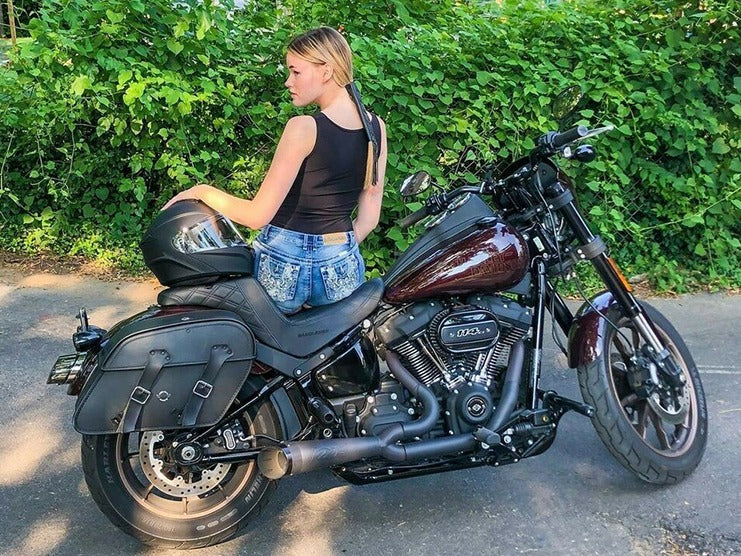Table of Content
| Rules of Motorcycle Passenger Etiquette | |
|---|---|
| Get Appropriate Riding Gear | Helmet Jacket Protective Goggles Gloves Long Riding Pants Boots |
| Familiarize Yourself with the Motorcycle | Check the Motorcycle’s Features Learn How to Mount & Dismount |
| Stay Close to the Rider | Get as Close to the Rider’s Back as Possible Without Touching |
| Stay Still While Seated | Get Comfortable Avoid Shifting Keep Movement to a Minimum |
| Mind Your Weight During Braking & Turning | Shift Weight Backward When Braking Keep Body Neutral When Turning |
| Listen to the Rider’s Instructions | Pay Attention to Any Instructions Respond Immediately |
| Help with Navigation | Look Up Directions for the Rider Keep on the Lookout for Streets, Roads, Landmarks, etc. |
| Communicate with the Rider | Speak Loudly Use Hand Signals Warn of Any Road Hazards Inform of Any Discomfort |
When you hear the word “passenger,” you likely will imagine an individual sitting in a comfy seat looking at their phone or sleeping while the seat reclines in a car, van, or any other four-wheeler. However, the role of a passenger on top of a motorcycle capable of two-up riding is a bit different.
Because motorcycles lack the benefits of a full canopy, seat belts, and airbags, passengers are more vulnerable when sitting on two-wheelers. For motorcycles, riding with a passenger could affect handling, braking, and acceleration due to having lighter frames. Even the slightest change in weight distribution due to another person being on board could make riding slightly harder. Because of this, the passenger cannot be passive throughout the length of motorcycle trips.
If you are planning to ride with a friend or family member as the passenger, you must know what contributions you have to make to ensure the rider finds it easier to control their vehicles. This article will discuss the basic rules of motorcycle passenger etiquette, including responsibilities, preparations, and behavior.
1. Get Appropriate Riding Gear

1.1 Helmet
You will need a DOT-approved helmet to protect your head from severe or fatal injuries due to heavy impacts. The DOT, or the Department of Transportation, is responsible for creating and regulating laws regarding motor vehicles. A DOT-approved helmet should have a sticker with the department’s symbol on the exterior. Though there are several types of motorcycle helmets, the one that provides the most coverage is the full-face helmet. The full-face helmet should include a durable shell, a secure chinstrap, a clear visor, and fits comfortably around the shape of your head.
1.2 Jacket
Wear a tear-resistant jacket constructed from leather or a similarly durable fabric to ensure that your back does not become scratched if you fall off and slide on the road. To help contribute to the motorcycle’s visibility, make sure your jacket comes in a bright color and have reflectors sewn on.
1.3 Protective Goggles
In case your helmet does not have a visor, make sure to purchase a pair of protective goggles to shield your eyes. Besides giving you a clear view of your surroundings, the lenses should be strong enough to repel dust, wind, bugs, or other small flying debris.
1.4 Gloves
To protect your hands from freezing winds and getting scratched if you fall on the road, you must wear gloves made of thick and tear-resistant materials. The thick fabric should provide insulated padding to keep your fingers and knuckles warm and protected.
1.5 Long Riding Pants
Wear long-riding pants that reach your ankles to prevent your legs from becoming scraped if you fall off your motorcycle. Long-riding pants should be constructed from tear-resistant fabrics with padding.
1.6 Boots
To protect your feet and ankles, you must wear boots with heavy and thick soles that reach above your ankles. Make sure your boots are built from heat-resistant materials to ensure they don’t melt or catch fire due to being close to the exhaust pipes.
2. Familiarize Yourself with the Motorcycle
2.1 Check the Motorcycle’s Features
You should visit your rider to check out their motorcycle before going on a trip. You do not need to know the specific specifications or model, but it helps to know which controls, safety features, and parts it has to ensure they are suited for two-up riding. For example, it is unsafe to ride on a motorcycle with no handholds, a separate passenger seat, and additional footrests. You can refuse to get on a motorcycle if you feel it is unfit to support another person. To carry essential things and gear check if the motorcycle luggage bags is installed like saddlebags, sissy bar bags, tank bags and swing arm bags.
2.2 Learn How to Mount & Dismount
Even if you are familiar with riding motorcycles, it is best to practice learning how to mount onto and dismount from the passenger seat. The seat size and the height of the foot pegs and passenger seat may differ between models. Knowing how high and how much strength to apply when getting on or off the passenger seat will keep you from accidentally injuring yourself due to falling. Also, this practice will teach you to wait until the rider gets on first and steady their ride before you follow suit.
3. Stay Close to the Rider

When seated behind the rider, try to get as close to their back as possible without obstructing their movements or physically touching them. Also, make sure not to get so close to the rider that your helmets start to hit each other. Make sure there is enough distance between you and the rider to still scan your surroundings while keeping most of the rider’s back within your peripheral view. This way, you can still enjoy the scenery while keeping an eye on the rider’s body movements.
4. Stay Still While Seated
When settling into a passenger seat, make sure the cushion and backrest (if there is one) rest fully against your body to ensure optimal comfort. Because once you are on the road, there is little room to move around and reduce discomfort if you experience cramps in your back or bottom. Try to keep any movement to a minimum since any shift in your body weight could cause the motorcycle to shake and make it harder for the rider to maintain balance.
5. Mind Your Weight During Braking & Turning

5.1 Braking
When approaching a red light or stopping behind another vehicle, you should prepare to shift your weight backward before the rider begins to apply the brakes. Make sure to plant your feet against the footrests to stabilize your body. Do both steps earlier rather than at the moment the brakes are applied to keep yourself from accidentally slamming forward into the rider’s back.
5.2 Turning
When approaching a turn on a street or highway exit, do not intentionally lean into or against the direction of the turn. Instead, keep your body relaxed and let it naturally lean towards the direction of the turn to keep your weight centered. The lack of uneven weight distribution will make it easier for the rider to maneuver without worrying about making adjustments to compensate.
6. Listen to the Rider’s Instructions
On the road, the rider is behind the handlebars, operating the controls, signaling to other drivers, and making sure you are safe. Because the rider will likely be the first to spot any hazards, traffic, etc. on the road ahead, it is prudent that you listen for and comply with any instructions laid out. If the rider says to adjust your body towards a specific direction or prepare to stop, respond immediately to ensure no mishaps that could lead to an accident.
7. Help with Navigation

Though the rider could use a GPS or their phone to provide directions to a destination, constantly listening for or looking at a screen could be a potential distraction. To help the rider focus on the road ahead, you can offer to look and read the directions aloud for them. This will also keep you active as you have to constantly watch for the specific streets, roads, and landmarks along the route.
8. Communicate with the Rider
8.1 Speak Loudly
When communicating with the rider, whether to ask questions or point out any potential danger, make sure to speak in a loud voice so that you can be heard over the sound of incoming wind and nearby traffic. Try to keep your sentences as short as possible or use simple words to describe anything along or on the road.
8.2 Use Hand Signals
If speaking loudly does not work, you can try to use hand signals instead. Make sure you are visible to the rider in the side mirrors when communicating. As part of getting their licenses, all drivers and motorcyclists have to learn hand signals in case of broken turn or brake signals. Though not as reliable as speaking aloud, it helps to read motorcycle handbooks and memorize the hand signals just in case.
8.3 Warn of Any Road Hazards
Though your vision is blocked slightly by the rider’s back, you can still actively swivel your head and look for any obstacles or vehicles that present a potential danger to the motorcycle. If you see anything that could cause damage to the motorcycle, inform the rider immediately since you cannot be sure if the rider has already spotted the road hazards.
8.4 Inform of Any Discomfort
If you feel sick, uncomfortable, or in pain, make sure to tell the rider immediately so they can find a safe place to pull over and stop as soon as possible. Discomfort could hinder your ability to stay still and distract you when being told instructions or being on the lookout for road hazards.
9. FAQs
9.1 What is the minimum age for motorcycle passengers?
Though the specific age limit for motorcycle passengers differs between U.S. states, the average age range is between five to eight years old. When bringing younger passengers aboard, they must be tall enough to reach the footrests and be able to understand the rider’s instructions.
9.2 Is it harder to ride with a passenger?
When riding with a passenger, the motorcycle has to support extra weight which will affect handling and braking distance. The extra weight means that the rider has to steer, turn, or brake earlier since the motorcycle will need more distance to slow down to an appropriate speed while maintaining balance.
9.3 Can a passenger sleep on a motorcycle?
Yes, it is possible if the motorcycle has a seat with a tall backrest and sidebars to keep the passenger upright and secure atop the vehicle. However, you may need to add aftermarket parts or make modifications.
10. Conclusion
Though many people would assume that the passenger contributes little to the motorcycle riding experience, they actually play an active role in ensuring the safety of the rider, pedestrians, and other drivers sharing the road. Rather than just coming along for the ride, motorcycle passengers have to take it upon themselves to prepare the appropriate riding gear and get used to riding on a new two-wheeler. On the road, motorcycle passengers do not get to sit back and kick up their feet. They have to be of help to the rider in any way they can, whether helping with braking or turning, reporting any obstacles on the road, or serving as a navigator. While this may seem like a stressful role, being a motorcycle passenger can be fun if you look at it from a certain perspective. Rather than being a passive observer, you get to be a reliable aid that supports the rider making your cruise or touring experience possible.













Leave a comment
All comments are moderated before being published.
This site is protected by hCaptcha and the hCaptcha Privacy Policy and Terms of Service apply.